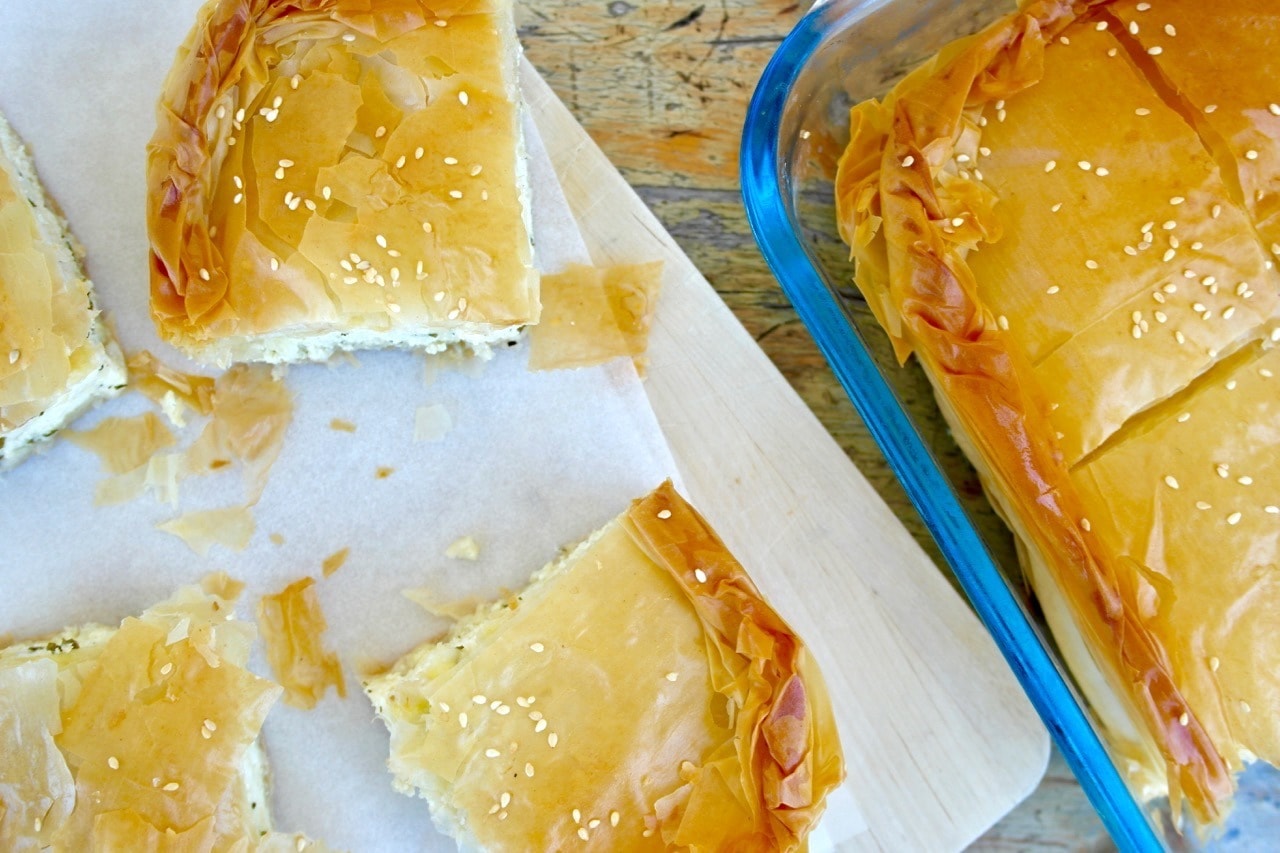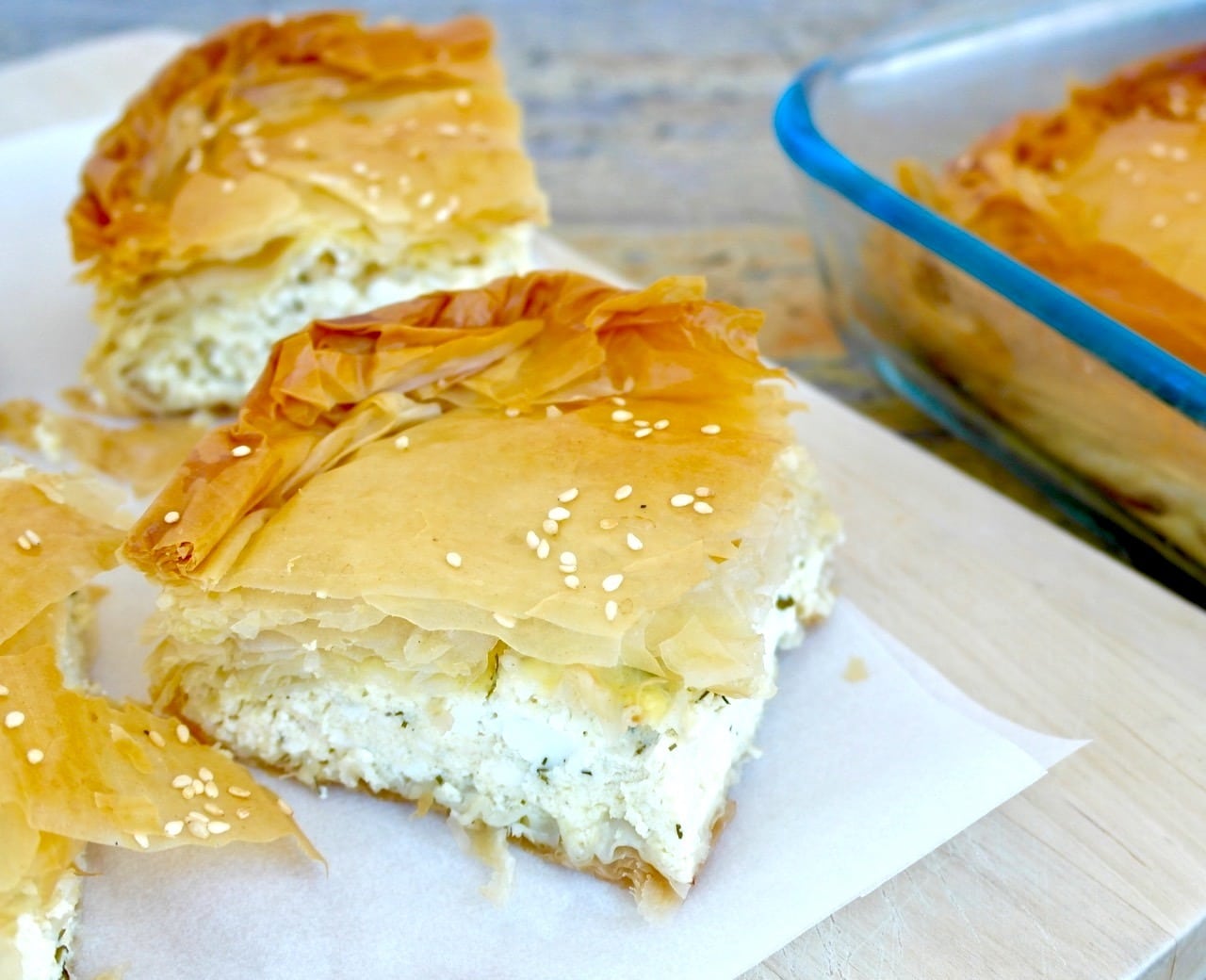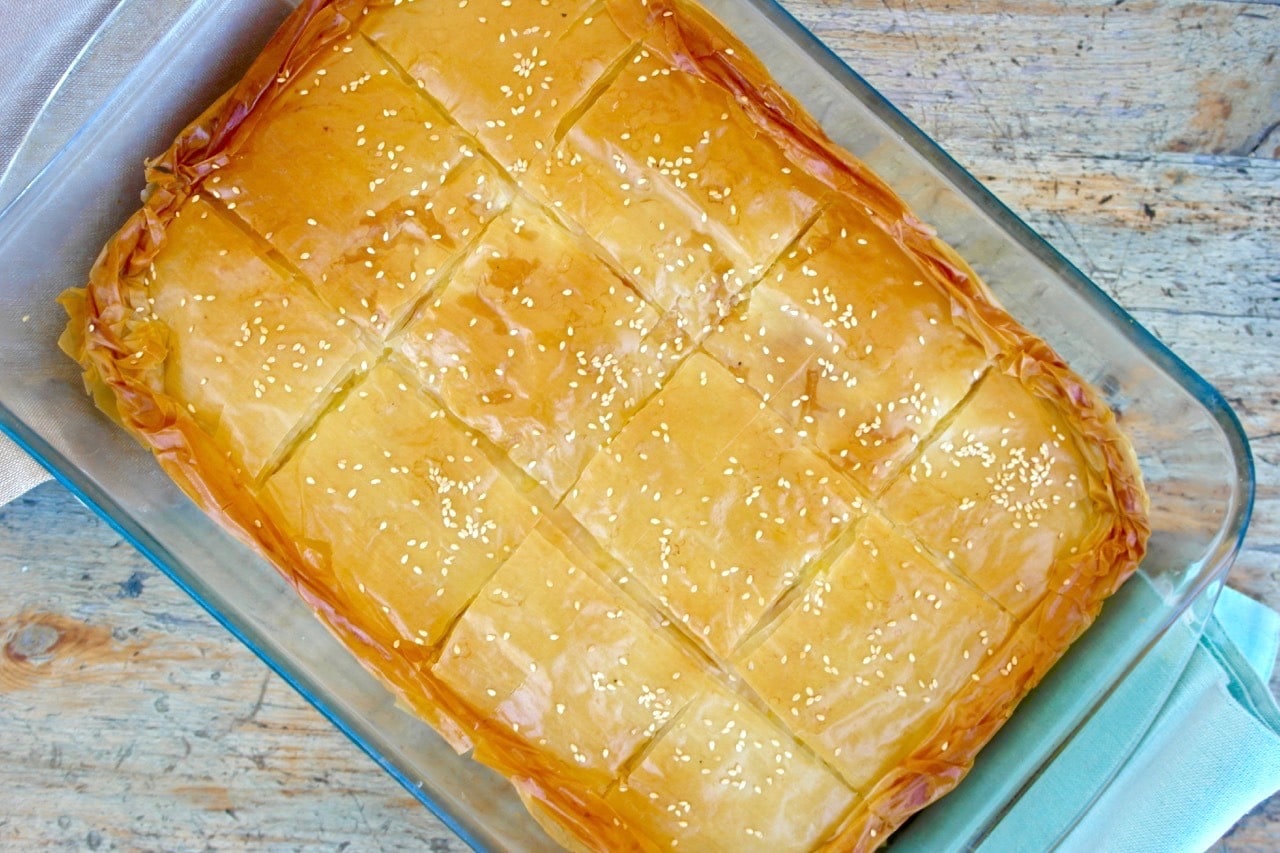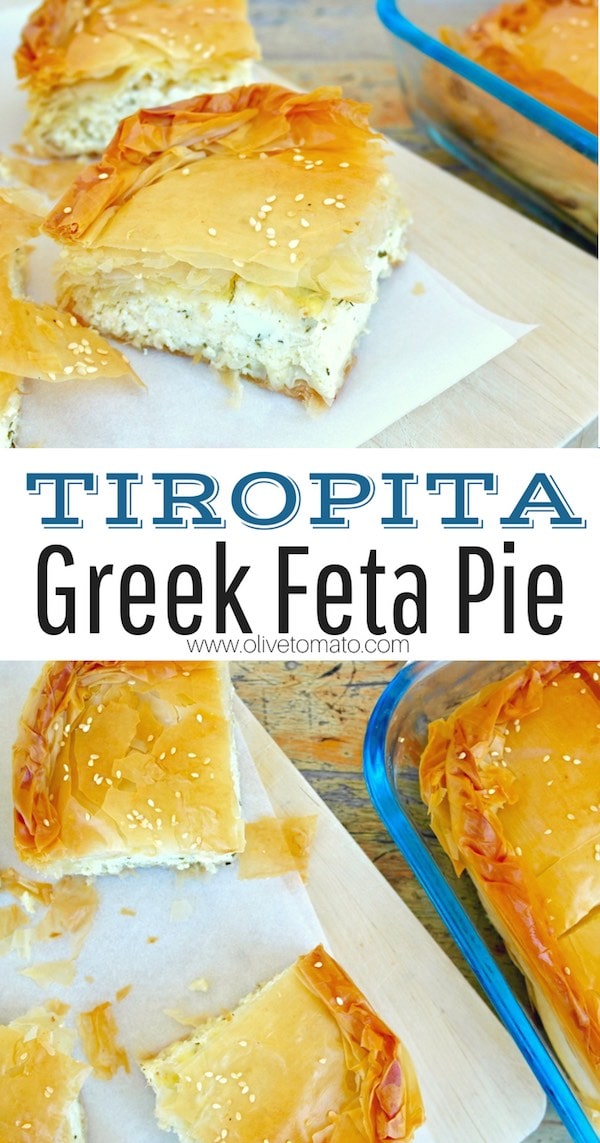Traditional Tiropita – Greek Feta Cheese Pie
The most popular Pie in Greece, and probably the most delicious. Rich and tangy feta filling wrapped in crispy phyllo. Get the authentic recipe for traditional tiropita.

The most popular pie or pita in Greece is the tiropita or as you may know it: Greek cheese pie. While spanakopita is equally popular, tiropita is the preferred pie for all times of the day and most often for breakfast. It is not uncommon to see signs in coffee places advertising a breakfast combo of coffee and tiropita . The difference between a spanakopita and tiropita is that spanakopita includes spinach and feta (sometimes only spinach) whereas tiropita only has cheese in its filling.
And while it is a popular street-food it is also a popular dish people make at home. There are many tiropita variations, the traditional version contains feta, eggs, homemade phyllo and olive oil. There are also the mini triangle tiropitakia, most often served at parties, tiropita shaped like a snail or single serving tiropites that come in various shapes. During one period about 60-70 years ago, the tiropita that contained béchamel and made with puff pastry (instead of phyllo) became popular. These variations were not only unhealthier but did not taste as good as the real thing, they were a somewhat westernized version influenced by French cuisine, but did not compare to the authentic version. And I have to say, the taste of the traditional cheese pie is amazing. Tangy feta along with the crispy phyllo is truly addictive. I remember fondly the small triangle cheese pies my mother and her friends would make for family get-togethers and parties, they literally made at least a hundred even if we were only a few of us… half of them were gone by the time the party started.

This particular recipe is made with the thin phyllo, (you can also make your own thicker phyllo using this recipe) feta and another fresh cheese. The phyllo which is called kroustas, does not contain any fat and therefore you need olive oil for brushing in between the phyllo layers. If you decide to make your own olive oil phyllo, (this is a thicker type phyllo/crust) you do not need to brush with olive oil. It is quite easy to put together and the key to a good tiropita is using good feta and if you are using the thin phyllo, to use enough olive oil. Remember to buy phyllo that contains no added fats.
A word about the salt. Since the main ingredient in the tiropita is feta, you will not need to add additional salt to the mixture. Typically we will add a bit of a less salty, fresh cheese such as anthotiro or if you cannot find it, you may add ricotta. For a lower sodium filling you can adjust the amounts of cheese, for example you can add more of the fresh cheese and less feta, but feta is what really gives the character to this pie. You can check my recipe for low sodium cheese pies here. Generally though, you want to keep the weight of the cheese constant, so for this recipe the total weight for the cheese is 26 ounces (75 grams).

What to serve tiropita with
Tiropita can be consumed as a snack, for breakfast and as a meal. I serve it with a seasonal salad (usually a Greek style salad with tomato and cucumber in the summer, or a green or cabbage salad in the winter). And it is also good (as all pies are) as school lunch.
Make ahead
You can also assemble and freeze the whole pie before baking, or after baking you can wrap 2-3 pieces together and reheat for a quick snack or meal.
If you prefer to do the small triangle tiropita, you can use the same filling and you can checkout the technique of making triangles here.
Traditional Tiropita – Greek Cheese Pie

Ingredients
- 17 ounces 500 grams feta
- 9 ounces 250 grams fresh anthotiro or ricotta
- 2 tablespoons fresh chopped mint or 1 tablespoon dry
- 2 tablespoons fresh chopped dill or 1 tablespoon dry
- Freshly ground pepper
- 3 eggs
- 1 tablespoon olive oil plus more for brushing
- 12 phyllo sheets defrosted
- sesame seeds optional
Instructions
- Preheat oven at 350 F (180 C)
- Grease (with olive oil) a 9X13 inch (25X35 cm)casserole dish or pan
- In a large bowl smash the feta and anthotiro with a fork.
- Add the mint, dill and pepper and mix.
- In a small bowl beat the eggs and add them to the cheese mixture along with one tablespoon olive oil. Mix well.
- Prepare your working area so that you have space to spread the phyllo.
- Remove your first phyllo sheet carefully and spread it on the bottom of the pan. If it is too big you can scrunch it to fit. Brush with olive oil. I often use an olive oil spray bottle instead. Place the second phyllo on top of the first phyllo and brush with olive oil and continue until you have spread 6 sheets of phyllo.
- Spread the cheese mixture over the phyllo making sure it is spread evenly.
- Cover with 5-6 more phyllo sheets repeating the same process (brushing with olive oil). Make sure that you do not scrunch the final 2-3 phyllo sheets.
- Brush the top layer with olive oil and score. Cut only through the phyllo (not all the way down).
- Sprinkle with sesame seeds, splash a bit of water on top with your fingers and place in the oven.
- Bake for about 40 minutes. Lift side slightly to make sure the bottom is baked. Place on the bottom of the oven for another 5 minutes.
- Let it cool for 15 minutes and cut in pieces.
- Keep in refrigerator. You may reheat it at about 280 degrees or you can eat it at room temperature.
Save for Later and Pin It!
Photos by Elena Paravantes © All Rights Reserved


Hello Elena… Today I was looking for a traditional Greek recipe for tiropita…and I was quickly transported to your site! Your recipe sound wonderful and I am looking forward to trying it.
Over all the years of my adult life, I’ve loved Greek food and I’ve tried many very good Greek restaurants. Whenever I’m lucky enough to find tiropita on the menu, I will always, hands down, choose the tiropita over the spanakopita. It’s always been delicious…but I’ve never seen or tasted dill, mint or sesame seeds in it. I’m wondering if the old-school Greek recipes had those items in them or is this your own personal, unique recipe? I’m very curious about this.
Thanks for your very enjoyable site! Bravo!
Mary Ann
Thank you for your comments. Traditionally many homemade pies, the home cooks add a herb such as parsley. This recipe is my grandmothers who would always add mint, as it pairs beautifully with feta. You typically find sesame seeds on the small cheese pies in bakeries here in Greece.
Made this today – fantastic, though my filo ended up scrunched, it still looked and tasted good. Next time though I shall cut back on the feta as the brand I used was too salty. Absolutely rapt and look forward to making it again.
Excellent, made this last weekend and every body loved it!
Excellent recipe and so easy. Thank you!
Thank you Maria!
Hi, Elena. Thank you so much for all you offer on this website. I was recently diagnosed with crohn’s disease and my doctor wants me to follow a gluten free Mediterranean diet. Your site has been so helpful during this transition. Can this recipe be made crustless, or is the phyllo required for it to hold together?
I would really like it if you could include the calories and protein, etc breakdown of your recipes. I love all of them so far
Hi Elena
I am new to your website and I am wondering whether you post the nutritional values of your recipes per serving. It would be great to know!
I tried this recipe and it is absolutely wonderful! I replaced the eggs with a mixture of oil, water and baking powder.
In Malta we have a similar pie, called “Torta tar-ricotta” (rikotta pie). It does not contain feta cheese and it’s usually done with short crust pastry.
I posted some photos of my Tripota here: https://www.instagram.com/p/BjzyRccA-CM/?taken-by=colettes_kitchen_
Thank you for all the lovely recipes and the interesting blogs and newsletters.
Thanks for sharing Colette!
I love your site. Just the other day I was wondering out loud to my wife, “What can we do with feta cheese that we haven’t done?” You just supplied the answer. Thanks. And your photography is really quite good. That said, the white of the feta cheese in some of your shots is blown out, lacks detail. A brief visit to a program like Photoshop might reveal hidden detail in the images under question. A small criticism when considered in the scheme of things.
Thank you Ken for your comment and tips!
I love to eat Tiropita for breakfast and as a snack. It’s delicious as part of a meal too, especially with a big Greek salad! I use imported Greek feta cheese whenever I can find it here because I think the goat milk adds a great flavor to the recipe.
Just what I was looking for! I ate one in the Athens airport and have been craving it ever since. It seems like the perfect after-school snack for my daughter, so I was hunting for an easy recipe.
As an aside, I’m delighted to have found your blog. My husband and I visited Greece for the first time last September and returned determined to go back . . . but also determined to eat more like Greek people in the meantime. Neither of us had ever felt healthier than we did after those two (fairly decadent) weeks!
Thank you for the recipe. I was asking a friend who bought it to work and she explained it to me with no measurements. I am going to make this. I have just one question. She mentioned we should add milk and egg mixture to cover the casserole. Is this necessary?
Thanks Carmalita. No it is not necessary to add milk, a brush of olive oil is fine.
I love that, and am glad to have a recipe to make it at home. Here we get a pressed goat ricotta from Skotidakis (a Greek-Canadian dairy producer half way between Montréal and Ottawa) and I’ve mixed that with feta to make dishes that aren’t too salty for friends who have to watch their salt consumption.
I suppose that the béchamel and puff pastry version was a form of postwar “modernity”, like the rush to eat red meat after wartime shortages and sometimes famine. In France there is a division roughly following the Loire between a kind of northerly-European cooking and Mediterranean or near-Mediterranean food. Nowadays many northerly French will prefer the food of Provence for reasons of health and taste, as well as the food of former French colonies and protectorates (North Africa, Lebanon).
Thank you for your comments and your historical insights!
I try to eat no dairy and am mostly vegan but once in a while my cheese light goes on. I have made tiropita before but for my health concerns, I would use fat free feta, egg beaters, and good margarine-I like Earth Balance Buttery Spread. As far as the ricotta, I might process toful to get the consistency of the ricotta. I am glad that you posted this. It is always good to have new ideas.
Louise Grey, why would you eat no extra-virgin olive oil? It is vegan by nature and more nutritious than any form of margarine, even the “healthful” kinds. And there is no reason to prefer fat-free feta in terms of veganism; both are produced by mammals, and with the fat-free you are losing a key component of the cheese.
Thank you for sharing Louise